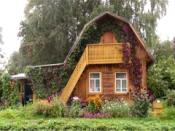Search
Login
Choose a drill for wood, how to choose the right, expert advice
Each owner with more or less versatile construction experience will agree that rare work on a construction site or even minor repairs will do without drilling wood. That is why in the arsenal of any builder there should be a drill, which is recognized as a universal tool necessary to perform construction tasks of any complexity and direction. Today's market offers the consumer a large number of different types of drills, and in order to understand this wide variety and choose the right tool, we suggest you familiarize yourself with the proposed materials.
Content
- Drill. General recommendations for selection
- Wood drill. We select the necessary types. Wood twist drill
- Long and feather drill. We are looking for a compromise video
- Core and Forstner drills. Tips for furniture makers
- How to sharpen a drill on wood? Key recommendations
Drill. General recommendations for selection
Before proceeding to the direct recommendations for choosing a drill for wood, we present to your attention standard recommendations for choosing a drill. A quality tool is characterized by the absence of all kinds of chips, scratches, dents and any other integrity violations. When revealing cosmetic defects, we must not forget that the color of the drill is one of the important operational characteristics of the tool, as it allows you to determine the finish of the drill, which is designed to harden the tool. So:

1. The black color of the drill was subjected to overheating in order to increase strength;
2. Golden yellow drill treatment to relieve metal stress;
3. A bright gold color indicates that the titanium nitride was used in the processing of the drill, which is used to increase the operating life;
4. The shade of gray steel indicates the absence of any processing.

Modern drills are mainly equipped with a set of drills, but they turn out to be mainly modifications of the same product, differing only in length and diameter. That is why you have to independently choose different types of drills that will cope with various tasks.

Wood drill. We select the necessary types. Wood twist drill
The first in this set should be a twist drill on wood, the diameter of which varies from 3 to 52 mm.

This type of drill is supplied with a tip, due to which the tool does not slip off the work surface.

The tapered shank also helps to pinpoint where holes are drilled. When choosing a drill, it is important to remember that the number of revolutions during drilling directly depends on the diameter of the product: when working with soft wood and using a drill whose diameter does not exceed 14 mm, it is recommended to set 1800 revolutions per minute, when working with hard rocks, respectively 900 revolutions . As a result, a ratio is obtained according to which the drilling speed is inversely proportional to the diameter of the tool. By adhering to this rule, you can extend the life of your tool.


Long and feather drill. We are looking for a compromise
An important tool in the set is a long drill on wood. When choosing such drills for wood, the dimensions of which directly depend on their diameter, it is important to consider the size of the electric drill itself, since a tool with a diameter of 10 mm will reach a length of 45 cm and have an appropriate weight. A drill equipped with such a drill is unlikely to be able to make at least a few revolutions, and that is why, when working with such drills, builders recommend using slow-speed drill mixers.

The presence in the set of screw drills on wood is due to the fact that it is often necessary to drill holes in the material against the course of the fibers.
The diameter of this type of drill can vary from 10 to 50 mm, and the length from 400 to 1100 mm. At the end of such drills, you can find a small screw, characterized by fine thread, and the shape of the tool makes it easy to cope with the problem of chip removal.

In search of a compromise between a large-diameter drill, necessary for drilling large holes, and the weight of the tool, you need to enrich your set with a feather drill on wood. Such tools are sometimes called pen-type tools, since the hole is drilled due to a pen located at the end of the shaft of a certain length. But such a compromise option is also characterized by its drawbacks, since the shape of the pen drill complicates the process of chip removal, which is a very significant minus when working with holes of great depth. Often, such tools are used when drilling thick boards or fiberboards and are available with certain length indicators, often not exceeding 20 cm.

However, due to the ability to install an extension cord, you can significantly increase the length of the pen drill. The hexagonal shank, the presence of which are characterized by feather drills, allows you to firmly hold the drill in the cartridge. This is very useful when drilling holes for door locks.
Core and Forstner drills. Tips for furniture makers
Ring drills for wood or so-called crowns awarded this epithet due to external and structural similarities with the crown are indispensable in the set of drills of an experienced builder. The ability to make holes of the largest diameter, which neither spiral nor feather drills can handle, sets the ring drill apart from other drill options. Crowns outwardly resemble a ring equipped with teeth, and are sold in sets as nozzles on one base equipped with a centering drill.


For furniture makers and people related to the creation and repair of furniture, Forstner drills are useful, using which you can drill a blind hole with a flat bottom. The diameter of the tool, which is coated with a special protective alloy to extend the life of the tool, varies from 10 to 50 mm. The recommended number of revolutions when working with this type of drill is from 2500 to 1000, depending on the hardness of the processed wood species.

How to sharpen a drill on wood? Key recommendations
Do you know how to sharpen a drill on wood? This question interests all reasonable builders who want to extend the operational life of their working tool. Sharpening of the described tool is an event that only a master with rich experience can manage to cope with, which has been practiced more than once in this type of work. Therefore, before embarking on sharpening a new working tool, experts recommend getting a hand in, sharpening old drills, which in case of failure will not be so pathetic.


Sharpening a drill is not such a frequent event, since a sharpened tool is characterized by a long service life.

The most difficult moment in the sharpening process is considered to be the observance of the initial geometric and configurational features of the drill, that is, the degree to which it was sharpened during production. However, drills for working with wood, unlike their counterparts for metal and concrete, are made of milder steel and can be sharpened manually using a special file.
If you decide to use an electric sharpener, then you need to take care of organizing a stream of water, the flow of which will constantly pour on the tip of the drill, which is sharpened, protecting it from overheating. The drill is sharpened by the edge of the disk, and after the formation of the desired geometry of the drill, you need to fine-tune it by feeding the tool to the disk at a very slow pace, which will ensure high quality sharpening and its sharpness.


If frequent sharpening is planned, then experts recommend organizing additional equipment in which the drill will fit, thereby adjusting the angle of sharpening and making it constant.






